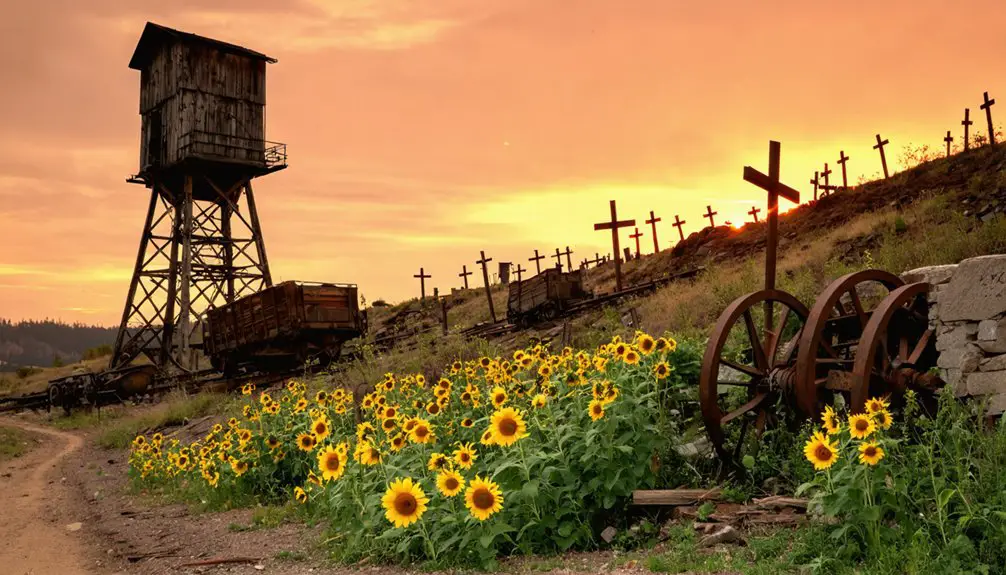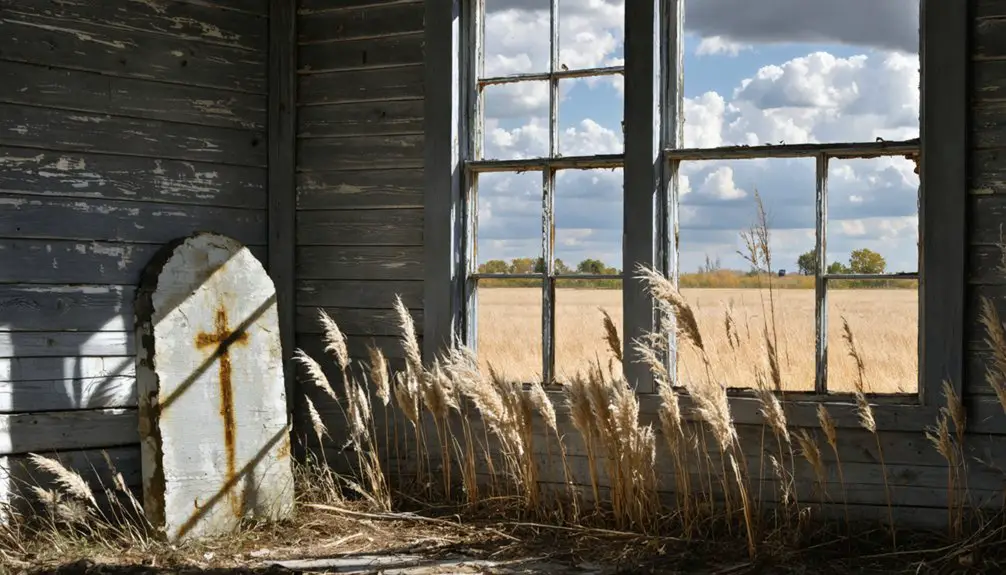You’ll find Adamson’s haunting remains in eastern Oklahoma, where this once-bustling coal town peaked at 3,500 residents during World War I. The catastrophic collapse of Mine Number One in 1914 killed fourteen miners and triggered the town’s rapid decline, shuttering fifteen mines and halting coal shipments. Today, concrete abutments, flooded mine shafts, and a granite memorial to the fallen miners tell the story of this community’s dramatic transformation from industrial hub to ghost town.
Key Takeaways
- Adamson transformed from a thriving coal mining town of 3,500 residents during World War I into a ghost town by 1957.
- A catastrophic mine collapse in 1914 killed fourteen miners and led to the closure of fifteen mines, triggering the town’s decline.
- The abandoned town site now features concrete abutments, flooded mine shafts, and partially submerged ruins under Lake Eufaula.
- Mining families used company scrip for purchases, and the town operated multiple mines that shipped coal via Rock Island Railroad.
- Physical remnants include weathered buildings along Route 66, ground subsidence from the mine collapse, and a memorial to fallen miners.
From Coal Boomtown to Abandoned Settlement
While many Oklahoma towns emerged from the Indian Territory’s coal boom, Adamson’s rise and fall epitomized the region’s volatile mining economy.
You’d find a bustling community of 3,500 residents during World War I, when mining techniques centered on slope mines extracting coal from the rich Hartshorne and McAlester beds.
Railroad integration through Rock Island and Katy lines transformed this former Choctaw Nation trading post into a thriving industrial hub. Similar to the landmark Adamson v. California case, the town’s history became an important study in economic and social transformation.
The tragic collapse of 1914 that claimed fourteen miners’ lives marked a turning point in the town’s prosperity.
The Fatal Day at Mine Number One
On September 4, 1914, a series of ominous cracking sounds at Adamson’s Mine Number One triggered a catastrophic chain of events that would claim fourteen miners’ lives.
You’ll find that mining safety protocols kicked in immediately – workers rushed to evacuate the ninth entry, roughly 650 feet below ground. While eighteen men made it to safety via the man-trip elevator, fourteen others remained trapped at the mine’s deepest point.
The disaster showcased the community’s resilience in its darkest hour. Investigators later determined that smoking or lights likely caused the explosion.
Anthony Benedict, the last miner to escape, later erected a monument honoring his fallen brothers.
The mine’s collapse, which sank the surface by nearly 10 feet, marked a turning point in Adamson’s history.
The town’s once-thriving coal industry never recovered, though the memory of those fourteen souls lives on.
Life During the Mining Heyday
During Adamson’s peak years from 1913-1919, you’d find the town’s fifteen mines operating around the clock, with each of the four major operations employing roughly 200 men who descended daily into the 35-degree sloped tunnels.
You could spot coal-laden trains departing frequently on both the Rock Island and Katy railroad spurs, while merchants bustled about serving the town’s 3,500 residents. Miners often relied on company scrip to purchase goods from the company-owned stores.
Walking through town, you’d encounter a vibrant mix of European immigrants celebrating their homeland traditions, with social life centered around community dances, “Choc” beer gatherings, and the shared experience of mining life. The tragic Mine No. 1 disaster in 1914 claimed fourteen miners’ lives when rescue attempts proved impossible due to collapsing tunnels.
Daily Mining Operations
As wartime demands for coal surged between 1913-1919, Adamson’s fifteen operating mines roared with round-the-clock activity, employing roughly 200 men per site across multiple shifts.
You’d find specialized crews working deep within the earth, including shot-firers like Anthony Benedict, timbermen securing tunnel supports, and handlers guiding mule-drawn coal cars.
If you’d ventured into these operations, you’d have descended about 700 feet via man-trips, traversing steep 35-degree northward slopes to reach the rich four-foot-thick coal seams.
The daily grind involved miners working in dark, cramped conditions, extracting coal that’d be quickly transported by Rock Island and Katy railroads.
Despite the demanding mining schedules and intense workforce dynamics, these laborers persevered, keeping Adamson’s economic engine running at full steam.
Community and Social Life
Mining life’s hardships were balanced by Adamson’s vibrant social scene, where you’d find a remarkable blend of cultures and traditions from across Europe.
You’d experience holidays from a dozen different countries, with cultural celebrations bringing together immigrant miners and their families in spirited gatherings.
After long shifts in the mines, you’d join your neighbors for dancing, drinking, and occasional gambling in local venues.
The town’s peak population of 3,500 supported a bustling social atmosphere where multi-generational families fostered tight-knit community bonds.
Churches anchored spiritual life, while local stores served as social hubs.
Even after the tragic 1914 Mine No. 1 collapse that claimed 14 lives, the community’s shared grief strengthened their connections, demonstrating the resilient spirit that defined Adamson’s social fabric.
The Ripple Effects of the 1914 Tragedy
You’ll find that the 1914 mine collapse triggered a devastating chain of economic effects, transforming Adamson from a bustling town of 3,500 residents into a ghost town as mining operations ceased and businesses shuttered.
Local support networks, once thriving through diverse immigrant communities and cultural celebrations, crumbled as families scattered in search of new opportunities. The tragic deaths of fourteen trapped miners forever changed the community’s spirit and resolve.
Similar to the decline of North Fork Town, the exodus of mining families marked the end of a generational occupation in Adamson, with many descendants never returning to the area that claimed their ancestors’ lives.
The exodus of mining families marked the end of a generational occupation in Adamson, with many descendants never returning to the area that claimed their ancestors’ lives.
Economic Impact Cascade
The catastrophic mine collapse of September 1914 triggered devastating economic shockwaves that rippled far beyond Adamson’s city limits.
You’d find the impact immediate and severe – 15 mines shuttered, including four major operations that had each employed over 200 workers. Daily coal shipments on the Rock Island and Katy railroads ground to a halt, disrupting the region’s entire supply chain.
The economic decline accelerated as workforce migration emptied the once-bustling town.
You’ll notice how Adamson’s population, which peaked at 3,500, plummeted as miners and their families sought work elsewhere. Local businesses folded, neighboring towns grappled with coal shortages, and manufacturing costs soared.
The disaster’s aftermath transformed a thriving community into a ghost town, leaving abandoned mines, flooded lands, and an economic void that was never filled.
Community Support Networks
Fourteen fallen miners sparked a remarkable wave of grassroots community response in Adamson following the devastating 1914 mine collapse.
You’ll find that despite armed guards initially deployed to control tensions, the town’s collective memory strengthened through oral histories and storytelling traditions.
Community resilience emerged as families joined forces to fund a granite memorial marker, with local businesses contributing support.
Joe Benedict, whose father perished in the disaster, became the memorial site’s dedicated steward until 2011, welcoming visitors and preserving these essential stories.
Even as Adamson’s population dwindled and social networks fractured, remaining residents maintained the memorial and cemetery, demonstrating unwavering commitment to honoring their lost miners.
Through these grassroots efforts, the community’s shared history endured despite the town’s physical decline.
Generational Mining Exodus
While community networks worked to preserve the miners’ memory, devastating ripples from the 1914 Union No. 1 Mine collapse fundamentally altered Adamson’s demographic fabric.
The disaster sparked a generational exodus from mining work, as families sought safer opportunities elsewhere. Today, the area maintains its small-town charm despite the dramatic population decline.
- Increased mining safety awareness led younger generations to pursue alternative careers
- Population plummeted from 3,500 during WWI to just a handful of residents by 1957
- Job diversification became essential as mining opportunities dwindled
- Surviving families relocated to find work in different industries
- Those who stayed shifted to non-mining livelihoods
You’ll find that Adamson’s transformation from a bustling coal town to a ghost town reflects a broader pattern of communities breaking free from dangerous mining traditions, choosing safer paths for their children’s futures.
Physical Remnants and Modern Landmarks
Standing as silent witnesses to Adamson’s mining legacy, concrete abutments and flooded mine shafts dominate the town’s remaining physical landscape.
Located in Pittsburg County, the ghost town retains a few residences and grocery stores from its past.
Similar to other abandoned mining sites, Adamson shows clear signs of neglect with piles of rubble and deteriorating buildings scattered throughout.
You’ll find evidence of the 1914 disaster in the 8-10 foot ground subsidence near the cave-in site, while abandoned Mine Number One‘s infrastructure showcases the scope of past operations.
Urban decay characterizes the few surviving structures along old Route 66, where weathered motels and service stations slowly crumble.
Nature has reclaimed much of the original town, with Eufaula Lake submerging portions of the settlement. Despite this transformation, historical preservation efforts maintain a memorial near the mine ruins, commemorating the trapped miners.
Railroad lines that once transported coal have vanished, leaving only traces of rights-of-way through the surrounding wilderness.
Remembering the Lost Miners

Deep beneath the Oklahoma soil, fourteen coal miners remain forever entombed following Adamson’s devastating mine collapse on September 4, 1914.
Today, mining memorials and local landmarks preserve their memory, while miner descendants continue sharing their stories throughout Pittsburg County.
- The Anthony Benedict monument stands near the original mine entrance, honoring those who never returned home.
- Armed guards once protected mine officials from grieving families who couldn’t recover their loved ones.
- The mine site sank 8-10 feet after the collapse, creating a permanent reminder of the tragedy.
- Local historical accounts since the 1960s have kept the miners’ stories alive.
- The disaster remains one of Oklahoma’s most tragic mining accidents, representing the true cost of early industrial labor.
Oklahoma’s Resource Towns: A Pattern of Boom and Bust
Throughout Oklahoma’s history, countless towns have risen and fallen with the discovery and depletion of natural resources. You’ll find this pattern of boom and bust particularly evident in places where resource extraction drove local economies. When oil, gas, or minerals were discovered, towns would spring up almost overnight, complete with hastily built businesses, worker camps, and the inevitable mix of saloons and gambling halls.
You’re looking at a cycle that defined Oklahoma’s development – railroads would determine a town’s fate, county seat elections could make or break communities, and oil booms could transform empty prairies into bustling settlements.
But these economic cycles were often short-lived. When resources dried up or prices dropped, towns like DeNoya and Three Sands quickly emptied, leaving behind abandoned buildings and fading memories.
Frequently Asked Questions
What Happened to the Machinery and Equipment Left in the Mines?
Like treasures frozen in time, you’ll find the abandoned equipment submerged when floodwaters filled the shafts. These mining relics deteriorated underground, becoming waterlogged historical artifacts rather than salvageable machinery.
Were There Any Successful Rescue Attempts of Miners Before the 1914 Disaster?
Based on available records, you won’t find evidence of major rescue operations before 1914’s disaster. Previous miner safety incidents typically allowed for body recovery, but Adamson’s complete collapse was uniquely devastating.
Did Any Families Receive Compensation After the Mine Collapse?
Like dust scattered in Oklahoma wind, you won’t find records of compensation claims paid to families. Despite common practices of the era, there’s no evidence any family support reached the victims’ loved ones.
What Was the Average Wage of Miners Working in Adamson?
You’d have found mining wages varying considerably: $2.50 daily in 1900, rising to $7.03 in 1922’s better economic conditions, then declining to $5 per day by 1931 during tougher times.
Are There Any Surviving Photos of Adamson During Its Peak Years?
Yes, you’ll find surviving photos from Adamson’s peak years, when 3,500 residents lived there. Historical preservation efforts have maintained images of the town’s 15 mining shafts, Baptist church, and cemetery.
References
- https://en.wikipedia.org/wiki/Adamson
- https://www.youtube.com/watch?v=5d-wHDTIbb0
- https://en.wikipedia.org/wiki/List_of_ghost_towns_in_Oklahoma
- https://www.lakeeufaula.com/news–travel–Is-There-A-Ghost-Town-Under-Lake-Eufaula/7265
- https://kids.kiddle.co/List_of_ghost_towns_in_Oklahoma
- https://usminedisasters.miningquiz.com/saxsewell/adamson.htm
- http://www.adamsonancestry.com/place-names/adamson-okla.html
- https://www.okhistory.org/publications/enc/entry?entry=CO001
- https://www.mininghistoryassociation.org/Journal/MHJ-v1-1994-Sewell.pdf
- https://usminedisasters.miningquiz.com/saxsewell/alderson.htm



